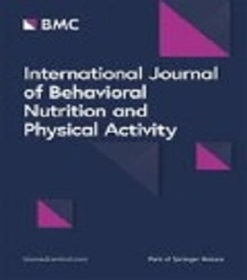#junkfluenced: the marketing of unhealthy food and beverages by social media influencers popular with Canadian children on YouTube, Instagram and TikTok
IF 5.6
1区 医学
Q1 NUTRITION & DIETETICS
International Journal of Behavioral Nutrition and Physical Activity
Pub Date : 2024-04-11
DOI:10.1186/s12966-024-01589-4
引用次数: 0
Abstract
Marketing of unhealthy foods to children on digital media significantly impacts their dietary preferences and contributes to diet-related noncommunicable diseases. Canadian children spend a significant amount of time on digital devices and are frequently exposed to unhealthy food marketing on social media, including by influencers with celebrity status who endorse products. This study aimed to examine the frequency, healthfulness, and power of unhealthy food marketing in posts by influencers popular with Canadian children on YouTube, Instagram and TikTok. The top 9 influencers popular amongst Canadian children aged 10–12 years were identified from the 2021 International Food Policy Study Youth Survey. A total of 2,232 Instagram, YouTube and TikTok posts made by these influencers between June 1st 2021 and May 31st 2022 were examined for instances of food marketing. Food products/brands were identified and frequencies were calculated for the number of posts promoting food products/brands, posts promoting products/brands classified as less healthy according to Health Canada’s Nutrient Profile Model (2018) and marketing techniques utilized. YouTube had the highest average rate of food marketing instances per post, at a rate of 1 food marketing instance every 0.7 posts, while TikTok and Instagram had instances every 10.2 posts and 19.3 posts, respectively. Overall, fast food restaurants was the most promoted food category (21%), followed by regular soft drinks (13%), snacks (11%), candy and chocolate (11%) and water (8%). The most frequently used marketing techniques were appeals to fun/cool (37%), the use of songs or music (28%) and the product being consumed (25%). In terms of healthfulness, 83% of the products/brands (87% of brands and 82% of products) promoted were classified as less healthy. Social media influencers play a substantial role in promoting unhealthy food products to children, primarily fast food items. Given the significant impact of such marketing on children, there is a need for ongoing government-led monitoring, and it is crucial to include social media and influencer marketing in marketing restrictions targeting children in Canada to safeguard this vulnerable demographic.#青少年影响:YouTube、Instagram 和 TikTok 上受加拿大儿童欢迎的社交媒体影响者推销不健康食品和饮料的行为
通过数字媒体向儿童推销不健康食品会严重影响他们的饮食偏好,并导致与饮食相关的非传染性疾病。加拿大儿童在数字设备上花费大量时间,并经常接触到社交媒体上的不健康食品营销,包括由具有名人地位的影响者为产品代言。本研究旨在研究在 YouTube、Instagram 和 TikTok 上受加拿大儿童欢迎的有影响力人士发布的帖子中,不健康食品营销的频率、健康程度和威力。从 2021 年国际食品政策研究青少年调查中确定了最受 10-12 岁加拿大儿童欢迎的 9 大影响者。在 2021 年 6 月 1 日至 2022 年 5 月 31 日期间,对这些有影响力的人物在 Instagram、YouTube 和 TikTok 上发布的共计 2,232 条帖子进行了研究,以查找食品营销的实例。对食品产品/品牌进行了识别,并计算了推广食品产品/品牌的帖子数量、推广根据加拿大卫生部的营养档案模型(2018 年)被归类为不太健康的产品/品牌的帖子数量以及所使用的营销技巧的频率。YouTube上平均每篇帖子的食品营销实例率最高,每0.7篇帖子就有1个食品营销实例,而TikTok和Instagram则分别为每10.2篇帖子和19.3篇帖子就有1个食品营销实例。总体而言,快餐店是推广最多的食品类别(21%),其次是普通软饮料(13%)、零食(11%)、糖果和巧克力(11%)以及水(8%)。最常用的营销技巧是呼吁有趣/酷(37%)、使用歌曲或音乐(28%)和消费产品(25%)。就健康性而言,83%的产品/品牌(87%的品牌和 82%的产品)被归类为不太健康。社交媒体影响者在向儿童推广不健康食品(主要是快餐食品)方面发挥了重要作用。鉴于此类营销对儿童的重大影响,有必要在政府的主导下进行持续监测,而且必须将社交媒体和影响者营销纳入针对加拿大儿童的营销限制中,以保护这一弱势人群。
本文章由计算机程序翻译,如有差异,请以英文原文为准。
求助全文
约1分钟内获得全文
求助全文
来源期刊
CiteScore
13.80
自引率
3.40%
发文量
138
审稿时长
4-8 weeks
期刊介绍:
International Journal of Behavioral Nutrition and Physical Activity (IJBNPA) is an open access, peer-reviewed journal offering high quality articles, rapid publication and wide diffusion in the public domain.
IJBNPA is devoted to furthering the understanding of the behavioral aspects of diet and physical activity and is unique in its inclusion of multiple levels of analysis, including populations, groups and individuals and its inclusion of epidemiology, and behavioral, theoretical and measurement research areas.

 求助内容:
求助内容: 应助结果提醒方式:
应助结果提醒方式:


